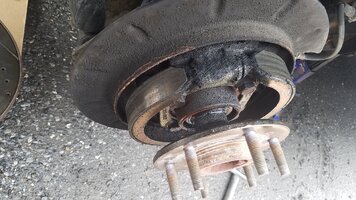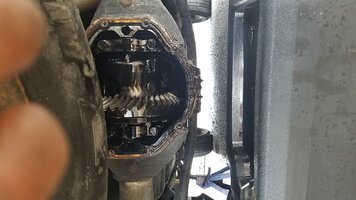Well, after taking care of this, some info for those who follow...
You'll need:
A 3/8" ratchet (no sockets)
Short 3/8" extension
3 quarts of synthetic 75W-90 oil (for most of us, this is Mobil 1 or Royal Purple)
A drain pan that can hold at least 3 qts of old fluid (and something to drain the old fluid into, for disposal / recycling)
A long neck funnel or suction gun (to refill with).
A couple of jack stands or ramps. Unless you're very thin and can fit under the truck & work with the wheels on the ground.
If you replace the gasket, a new one (or gray RTV, which is the one made for differential covers). See notes below for identifying your gasket / housing.
A torque wrench (3/8" is probably best - something that can measure 24 and 35 ft/lb)
Starting Out:
- It's probably a good idea to check the level before you begin, to get a baseline for where you're at, pre-change. If you do this right after driving the truck, GM advises to wait 5 minutes, so that the fluid has time to drain out of the axle housings, and back into the 'sump' (the diff housing.)
- While the recessed area of the fill & drain plugs is a bit shallow for a 3/8" extension, a ratchet alone fits very well in those spots - and there's enough room to *use* the ratchet alone (and probably a breaker or hammer, if it's been years since the plugs have been removed). The fill plug - which you should loosen *first* - will probably look rusted through, but it's just the outer surface.
- You'll have more room to work with the drain plug if you lower the spare tire (and it would be a good time to lube the cable after this job, if needed).
- Once you break the torque on the drain plug, and can turn the plug freely, swap the ratchet for a short extension. Keep inward pressure on the plug until you feel it wobble (similar to the engine oil drain plug, if you change your own oil.) You can then remove it from the housing and have a nice clean drain. Mine smelled like propane. Or maybe I farted...I can't remember.

(note: You may not have a drain plug; if you do, it will be forward of the cover, on the bottom of the carrier housing. If you don't, then you'll have to loosen the cover bolts. Yes, it's messier, but since you're taking it off, it's a good opportunity to examine the ring and pinion gear.)
- While the axle is draining, clean the drain plug. If the fluid that's draining is the factory fill, don't be surprised to find 1/8" to 1/4" of 'sludge' on the end of the plug (which is really metal filings from the axle.) As long as that material is 'soft', all is well. You don't need to worry about immediately replacing the plug, as there's no 'prime' to lose in the axle, like there is in an engine. So go have a beer and let the axle drain a bit!

When you get back, the
drain plug is torqued to
35 ft/lb - for ALL years / axles (I checked every years' service manual for you - you're welcome

(those of you with no drain plug:
Torque the
8.0" cover bolts to 20 ft/lbs,
and the
8.6" cover bolts to 18 ft/lbs,
in alternating sequence - and I'd do it in two passes, myself, although the manual does not specify it)
The OEM rubber gasket is considered reusable, but if you decide to replace yours...
The best way I've found to tell whether you have the 8.0" or 8.6" axle - BOTH have 10 bolts, but the gaskets are NOT the same...
- The 8.6" axle cover will look like a slightly flattened circle, is more round / smooth across the entire cover, and when you get the cover off, you'll see two extra 'holes' in the carrier housing at 3 o'clock and 9 o'clock (I have this one; my avatar indicates why).
- The 8.0" axle cover has 'pointed' ends at 12 / 6 o'clock, squared off ends parallel with the axle tubes at 3 and 9 o'clock, and a bulge in the cover running top to bottom (it's covering the ring gear, which sticks out of the carrier housing)
Xavierny25's post above shows the 8.0" axle carrier in the third picture.
(I think (?) most of the 4.2L with 3.42 gears got the 8.0" axle - both short and long wheelbase, and 2WD / 4WD.
- Don't ask me what axle size the AWD trucks got - I have no idea. Sorry!
If you want to be *absolutely* sure of your axle size, and you don't find the above info helpful - you will need to remove the cover and
measure the ring gear from end / end (outer diameter), which can be difficult with the gear in the housing.
(Now you know why I went through the differences in the covers, since both axles have the same # of bolts (10, remember?) I couldn't find this info anywhere on the web.)
- The service manual specifies 75w-90 *synthetic* lube (same as the front, for 4WD), and *NO* limited slip additive to be used for the 8.0" and 8.6" axle.
(In the *very* rare event you have a 9.5" axle (it's the ONLY one with 14 cover bolts), then additive is called for (IF you don't use synthetic gear oil, I'd imagine). Also, the fill plug on the 9.5" axle is in the middle of the stock diff cover, so you'll probably need less oil than the rest of us.
From the looks of it, the TBSS got the 9.5" axle, and we know all of those had 4.10s, as well).
If you have a 4.2L that was ordered with a 4.10 gear, you may have this oddball axle as well.
The 4.10 was not available for any of the 5.3L trucks (RPOs: LM4, LH6)
For the rest of us - 8.0" and 8.6" axles:
- You'll need (3) one quart bottles (and you'll have a little left over from the last one).
- M1 and Royal Purple will specify that they're compatible with LSDs - it's OK to use them as-is. You won't harm the diff as long as you don't add anything else to the fluid.
Filling the Axle
The 'final' level check should be done with the truck level (e.g.; as it would sit on the wheels - you don't need to use a bubble level, raise the front end, etc.)
There are two methods you can use to fill. The first is a long neck or flexible neck funnel. Expect to spill some fluid, no matter how careful you are - because the fill plug is at the top of the housing, and you're basically pouring horizontally. You can also try filling straight from the bottle, if it has an angled tip - but I still think you'll spill fluid (unless you attach some flexible tubing to the tip, perhaps.)
However - If you've seen May03LT's YouTube videos on the subject, you'll see he uses something better - a suction gun. If you can get one of these, it is a lot easier (and a LOT less messy) to get the oil into the diff. They run about $10-12 USD at the parts stores, and HF has them too. You can use them for the transfer case and front diff, too, so it's not a 1-use tool.
I found that smaller zip ties can be very useful for checking the level - bend it at a 90" angle, into an 'L' shape (the lock end s/b the 'short' end). Feed the longer end into the fill hole, and rest the short end on the bottom of the fill hole. Remove the zip tie and check the distance from where the fluid ends to the bend.
As far as 'what's full' - GM's spec says anywhere from just dripping out of the hole to 10mm (0.4 in) below the hole - is good. That's because when the axles are filled at the factory, they're filled by volume, not to a 'line'. So if you're within those tolerances, you're fine. Me, I fill till the fluid starts dripping out, given GM's wording.
Clean the
fill plug (some anti-seize wouldn't be a bad idea), and
torque to
24 ft/lb (yes, it's different than the drain plug, and again, it's the same spec for all MY / axles).
If you have no leaks - you are done. Time for another beer. And unless you're off-roading, racing, or doing a *lot* of towing, you should be good for the next 80K-100K miles. I know mine had to have the factory fill in it - and I have almost 150K on mine. I expect to get at least that much service out of the new fluid.















